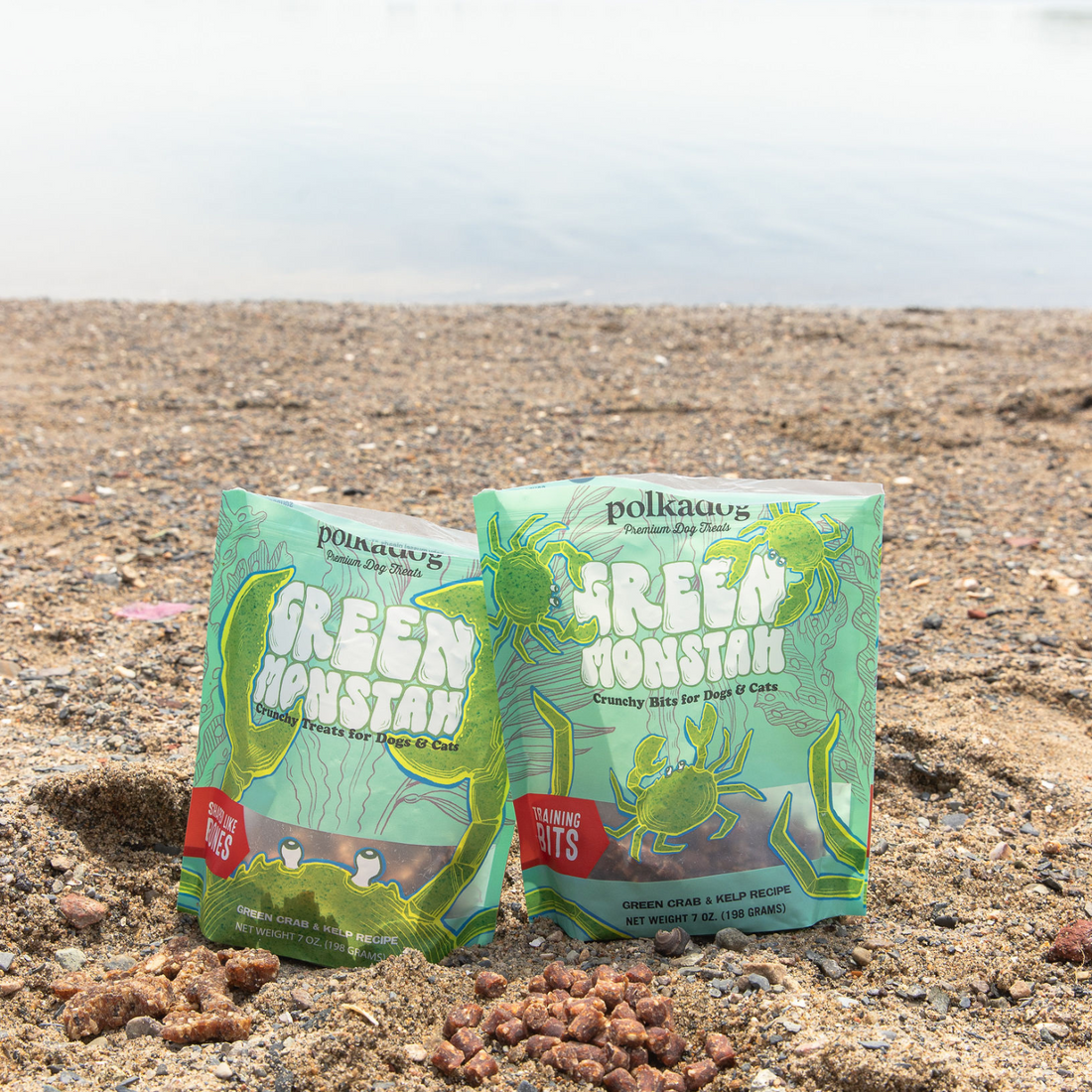
Invasive Impact: Celebrate Green Crab Week with us!
Green crabs might not be the ocean’s most charming residents, but they’re certainly some of the busiest and most notorious. These tiny invaders have been stirring up trouble in New England waters for over 200 years, disrupting ecosystems and outcompeting native species.
At Polkadog, we use green crab in our Green Monstah treats as part of our commitment to sustainability and supporting biodiversity in our waters. For Green Crab Week, we teamed up with Mary Parks from greencrab.org to learn more about what make green crabs such a menace and how giving them a new purpose might be exactly what our oceans need.
What’s one thing you hope people take away from Green Crab Week?
That green crabs are tasty and versatile in the kitchen! With restaurants from Bar Harbor to Oklahoma City participating, we’re excited to see how green crabs take shape on menus.
Why are green crabs such a big deal in New England waters?
Green crabs have been here for over 200 years and are now one of the most common crab species in New England. Green crabs impact some of New England’s most valuable fisheries and vulnerable ecosystems.
What kind of damage do green crabs cause, and how does removing them help restore balance?
Not only are green crabs voracious predators of native shellfish (like clams, oysters, and bay scallops), they also compete with native species and slice and uproot eelgrass while foraging for food. Eelgrass is a crucial habitat for fish, shellfish, migratory birds, and sea turtles. However, eelgrass also buffers storms, stores carbon, and improves water quality.
Since a single green crab can produce up to 185,000 eggs per year and they’re very established on the East Coast, we’ll never be able to get rid of them. But some research supports that targeted capture can mitigate their invasive impact.
Green crabs are here to stay. However, in a time when we’re losing access to so many species with climate change and overfishing, we finally have a seafood we can trap as much as we please without worrying about overfishing them.
What native species are most impacted by green crabs?
Green crabs love soft-shell clams and can consume up to 40 half-inch steamers in a day. They’re also big fans of wild and farmed oysters, bay scallops, mussels, and razor clams. Green crabs also compete with native crustaceans for food and habitat.
How can someone help with ocean conservation, even if they live far from the coast?
You don’t have to live close to the ocean to be connected to it! Eelgrass is a great example of an ocean ecosystem that helps terrestrial environments through storm buffering and storing carbon to fight back against climate change.
Anyone can get involved with ocean conservation, whether that’s through advocating for sustainable ocean and climate policy, virtual volunteering, or eating underutilized or invasive species like green crab.
A great place to start is by learning more about your watershed and indigenous stewardship practices and food systems.
How did green crabs end up in New England waters?
Green crabs were first introduced to Massachusetts 200 years ago in the ballast of ships. Ballast water from Europe containing microscopic larval green crabs was emptied into New England waters, enabling green crabs to take hold. This continued to happen across the East Coast, with different genetics introduced each time.
What’s one thing about green crabs that always surprises people?
How much of a global issue they are! Green crabs aren’t just an invasive species in New England, they’re also an issue on both coasts of Canada and the US and in South America, South Africa, Australia, and Japan.
What’s your favorite green crab fact to drop at pawties?
That you can make a mean martini with green crab! My favorite riff is a “hot and crabby” made with green crab brine (super salty green crab broth) and pepperoncini brine.
From threatening native shellfish to uprooting vital eelgrass beds, green crabs have become a serious force in New England’s coastal waters. But as Mary reminds us, they don’t have to stay a problem. Whether you're ordering a green crab dish at your favorite restaurant or choosing treats that help reduce their numbers, small choices can lead to meaningful change.
Happy Green Crab Week from all of us at Polkadog!
